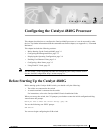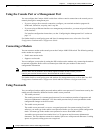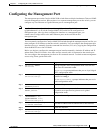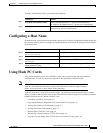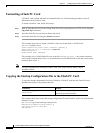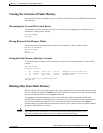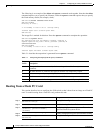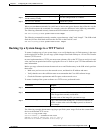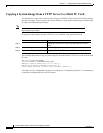
3-7
Catalyst 4840G Software Feature and Configuration Guide
78-10416-02
Chapter 3 Configuring the Catalyst 4840G Processor
Using Flash PC Cards
Viewing the Contents of Flash Memory
This section describes commands you can use with the onboard Flash memory SIMM (bootflash) and
Flash PC cards.
Determining the Current File System Device
To determine which file system device you are accessing, enter the pwd (print working directory)
command, as shown in this example:
SLB-Switch# pwd
bootflash
Moving Between Flash Memory Media
To move between Flash memory media, enter the cd command, as shown in this example:
SLB-Switch# cd slot0:
SLB-Switch# pwd
slot0
SLB-Switch#
Listing the Flash Memory Directory Contents
To list the directory contents of any Flash memory media, enter the dir command, as shown in this
example:
SLB-Switch# dir
Directory of slot0:/
1 -rw- 3509000 Jan 25 1999 19:46:25 cat4840G-in-mz.120-1.W5.6a.bin
3 -rw- 3509004 Feb 5 1999 19:46:25 cat4840G-in-mz.120-1a.W5.6b.bin
4 -rw- 2386 Feb 19 1999 17:25:36 startup-config
16384000 bytes total (9360836 bytes free)
SLB-Switch#
Deleting Files from Flash Memory
When you delete a file from Flash memory, the system marks the file as deleted, allowing you to later
recover a deleted file using the undelete command. Erased files cannot be recovered. To permanently
erase the configuration file, enter the squeeze command.
The squeeze command permanently removes files marked for deletion and pushes all the other
undeleted files together to eliminate spaces between them. To prevent data loss due to sudden power
loss, the squeezed data is temporarily saved to another location in Flash memory. The squeeze
command keeps a log of the functions performed so that if a power failure occurs, the system continues
the process when the power resumes.
Caution When deleting files from memory, be careful not to delete all the system images. If you
delete all existing system images, you can no longer download new images.



